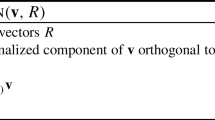Abstract
Consider the problem of computing the smallest enclosing ball of a set of m balls in ℜn. Existing algorithms are known to be inefficient when n > 30. In this paper we develop two algorithms that are particularly suitable for problems where n is large. The first algorithm is based on log-exponential aggregation of the maximum function and reduces the problem into an unconstrained convex program. The second algorithm is based on a second-order cone programming formulation, with special structures taken into consideration. Our computational experiments show that both methods are efficient for large problems, with the product mn on the order of 107. Using the first algorithm, we are able to solve problems with n = 100 and m = 512,000 in about 1 hour.
Similar content being viewed by others
References
R.H. Byrd, P. Lu, J. Nocedal, and C. Zhu, “A limited memory algorithm for bound constrained optimization” SIAM J. Sci. Comput., vol. 16, pp. 1190–1208, 1995.
J. Elzinga and D. Hearn, “The minimum covering sphere problem” Management Sci., vol. 19, pp. 96–104, 1972.
Bn. Gärter, “Fast and robust smallest enclosing balls” in Algorithms-ESA’99: 7th Annual European Symposium Proceedings, J. Nestril (Ed.), Lecture Notes in Computer Science 1643, Springer-Verlag, pp. 325–338.
B. Gärter, Smallest enclosing ball—Fast and robust in C++, http://www.inf.ethz.ch/personal/gaertner/miniball.html.
G.H. Hardy, J.E. Littlewood, and G. Polya, Inequalities. Cambridge University Press, 1952.
D.W. Hearn and J. Vijan, “Efficient algorithms for the minimum circle problem” Oper. Res., vol. 30, pp. 777–795, 1982.
J.B. Hiriart-Urruty and C. Lemarechal, Convex Analysis and Minimization Algorithm. Springer-Verlag: Berlin, Heidelberg, 1993.
X.S. Li, “An aggregate function method for nonlinear programming” Sci. China Ser. A, vol. 34, pp. 1467–1473, 1991.
N. Megiddo, “Linear-time algorithms for linear programming in ℜ3 and related problems” SIAM J. Comput., vol. 12, pp. 759–776, 1983.
Yu. E. Nesterov and A. Nemirovskii, Interior Polynomial Algorithms in Convex Programming. SIAM: Philadelphia, 1994.
Yu. E. Nesterov and M.J. Todd, “Self-scaled barriers and interior-point methods for convex programming” Math. Oper. Res., vol. 22, pp. 1–42, 1997.
F.P. Preparata and M.I. Shamos, Computational Geometry: An Introduction, Texts and Monographs in Computer Science, Springer-Verlag: New York, 1985.
M.I. Shamos and D. Hoey, “Closest-point problems” in 16th Annual Symposium on Foundations of Computer Science (Berkeley, CA, 1975), IEEE Computer Society, Long Beach, CA, 1975, pp. 151–162.
J.F. Sturm, “Using SeDuMi 1.02, a MATLAB toolbox for optimization over symmetric cones” Optim. Methods Softw., vol. 11 & 12, pp. 625–653, 1999.
P. Sun and R.M. Freund, “Computation of minimum volume covering ellipsoids” MIT Operations Research Center Working Paper OR 064-02, July, 2002.
R.H Tütüncü, K.C. Toh, and M.J. Todd, “Solving semidefinite-quadratic-linear programs using SDPT3” Math. Programming, vol. 95, pp. 189–217, 2003.
R.J. Vanderbei, “LOQO user’s manual—version 3.10” Optim. Methods Softw., vol. 11 & 12, pp. 485–514, 1999.
E. Welzl, “Smallest enclosing disks (balls and ellipsoids)” in New Results and New Trends in Computer Science, H. Maurer (Ed.) Springer-Verlag, 1991, pp. 359–370.
D. White, Enclosing ball software, http://vision.ucsd.edu/~dwhite/ball.html.
S. Xu, R. Freund, and J. Sun, “Solution methodologies for the smallest enclosing circle problem,“Comput. Optim. Appl.,” vol. 25, pp. 283–292, 2003.
G.L. Xue and Y.Y. Ye, “An efficient algorithm for minimizing a sum of Euclidean norms with applications” SIAM J. Optim., vol. 7, pp. 1017–1036, 1997.
Author information
Authors and Affiliations
Corresponding author
Additional information
His work was supported by Australian Research Council.
Research supported in part by the Singapore-MIT Alliance.
Rights and permissions
About this article
Cite this article
Zhou, G., Tohemail, KC. & Sun, J. Efficient Algorithms for the Smallest Enclosing Ball Problem. Comput Optim Applic 30, 147–160 (2005). https://doi.org/10.1007/s10589-005-4565-7
Received:
Revised:
Accepted:
Issue Date:
DOI: https://doi.org/10.1007/s10589-005-4565-7




